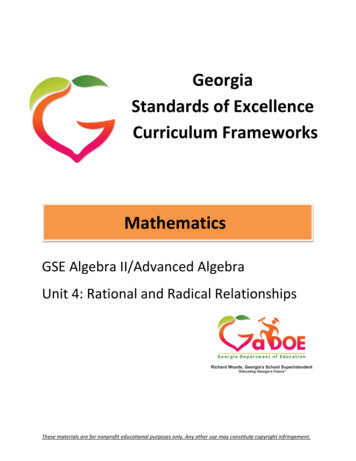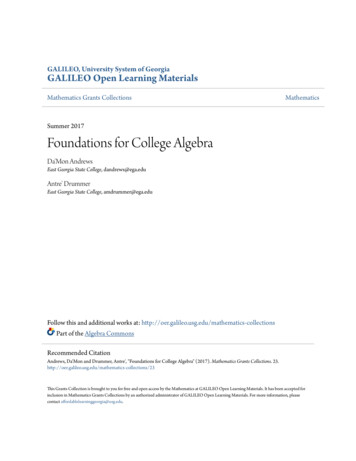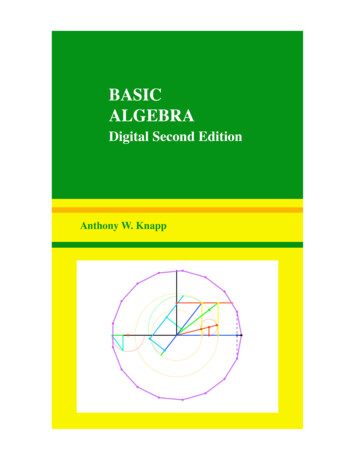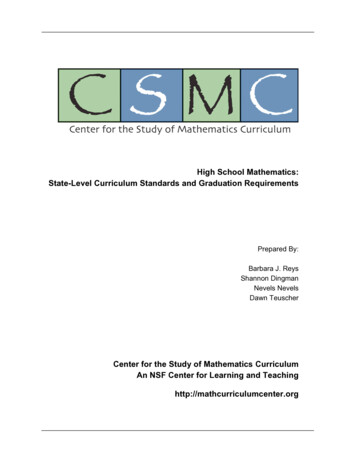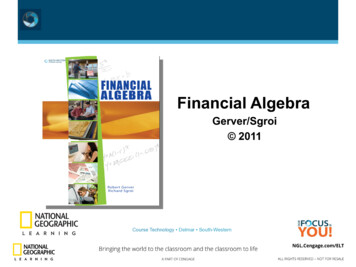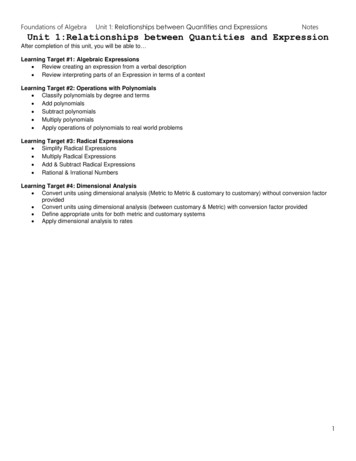
Transcription
Foundations of AlgebraUnit 1: Relationships between Quantities and ExpressionsNotesUnit 1:Relationships between Quantities and ExpressionAfter completion of this unit, you will be able to Learning Target #1: Algebraic Expressions Review creating an expression from a verbal description Review interpreting parts of an Expression in terms of a contextLearning Target #2: Operations with Polynomials Classify polynomials by degree and terms Add polynomials Subtract polynomials Multiply polynomials Apply operations of polynomials to real world problemsLearning Target #3: Radical Expressions Simplify Radical Expressions Multiply Radical Expressions Add & Subtract Radical Expressions Rational & Irrational NumbersLearning Target #4: Dimensional Analysis Convert units using dimensional analysis (Metric to Metric & customary to customary) without conversion factorprovided Convert units using dimensional analysis (between customary & Metric) with conversion factor provided Define appropriate units for both metric and customary systems Apply dimensional analysis to rates1
Algebra 1Day 1: Algebraic ExpressionsNotesDay 1 – Algebraic ExpressionsStandard(s):An expression containing variables (letters), numbers, and operation symbols is called an. An expression does NOT contain an equal sign.An example of an algebraic expression is 5x 7y – 3.In an algebraic expression, there are four different parts: coefficients, variables, constants, and terms.5x 7y - 3Variables are the letters in an expression.Coefficients are the numbers in front of the variables.Constants are the “plain numbers” or termswithout variables.Terms are separated by a or – sign and can be numbersand/or variables.Factors of each term are the numbers or expressions that when multiplied produce a given product.Practice: Complete the table below.ExpressionList TermsList Factors of 1stTermList CoefficientsList VariablesList Constants2x 5z - 3136m3 – 9m2 s – 4x2 7x -12
Algebra 1Day 1: Algebraic ExpressionsNotesCombining Like TermsTerms with the same variable raised to the same exponent are like terms.Like: 3x and -7xLike: 2y2 and 6y2Not Like: 4x and 6x2Why?Directions: Simplify the following expressions:4x 6y 3y21. -3x 6x2. y – 3 6 – 2y3.4. 8m 1n – 3 105. 9x – 10x2 7x – 36. x 2y 3x 9y3Distributive PropertyDistributive Propertystates .1. 5(x 2)2. -3(x – 4)3. -6(-2x – 3)4. 4x - 5(x – 1)5. -2(4 x) 4(2 – 8x) 56. 2(3 x) x(1 – 4x) 5Connect: Take the simplified expression from number 6 and answer the following questions:a. Identify all the terms:b. Identify all the factors:c. Identify all the coefficients:d. Identify all the constants:3
Algebra 1Day 1: Algebraic ExpressionsNotesEvaluating ExpressionsWhen you evaluate an expression, you are replacing the variable with what the variable equals:Evaluate 4x – 5when x 6Practice: Evaluate the following expressions if m 7, r 8, and t -2.a. 5m – 6b.rtc. 3m – 5td. t2 – 4rApplication: Answer the following questions:1. You earn 15n dollars for mowing n lawns.a. How much do you earn for mowing 1 lawn?b. How much do you earn for mowing 9 lawns?2. After m months, the length of a fingernail is 10 3m millimeters.a. How long is the fingernail, in centimeters, after 8 months?b. How long is the fingernail after three years?4
Algebra 1Day 2: Creating & Translating Algebraic ExpressionsNotesDay 2 – Creating & Translating Algebraic ExpressionsStandard(s):Creating Algebraic ExpressionsReview: TheCommutative and Associative PropertiesCommutative Property of Addition(order doesn’t matter)Associative Property of Addition(grouping order doesn’t matter)5 6 can be written as 6 52 (5 6) can be written as (2 6) 5Commutative Property of Multiplication(order doesn’t matter)Associative Property of Multiplication(grouping order doesn’t matter)5 x 6 can be written as 6 x 5(2 x 5) x 6 can be written as 2 x (6 x tsSumDifferenceOfQuotientPowerIncreased byDecreased byProductRatio ofSquaredMore thanMinusTimesEachCubedCombinedLessMultiplied byFraction ofTogetherLess thanDouble, TripleOut ofTotal ofFewer thanTwicePerAdded toHow many moreAs muchDivided byGainedLeftEachSplitRaisedPlusUse Parenthesis: The quantity of5
Algebra 1Day 2: Creating & Translating Algebraic ExpressionsNotesSubtraction and Division can be very tricky because order DOES matter unlike Addition and Multiplication.Take a look at the following verbal descriptions:AdditionThe sum of x and 4.MultiplicationThe product of x and 3.SubtractionThe difference of x and 5.DivisionThe quotient of x and 7x decreased by 5The ratio of x and 7Five less than xPractice: Write the expression for each verbal description:1. The difference of a number and 52. The quotient of 14 and 73. y decreased by 174. x increased by 65. The sum of a number and 86. 6 squared7. Twice a number8. 8 more than a third of a number9. 6 less than twice k10. Five divided by the sum of a and b.11. The quotient of k decreased by 4 and 9.12. 2 minus the quantity 3 more than p13. Half of the quantity 1 less than w14. Nine less than the total of a number and 2.15. The product of a number and 3 decreased by 5Practice: Write each as a verbal expression. You may not use the words add, subtract (minus), times, or divide.1.x22. a 93. 5n – 74. 3(y 7)6
Algebra 1Day 2: Creating & Translating Algebraic ExpressionsNotesCreating Expressions from a ContextScenario A: A local restaurant is busiest on Saturday evenings. The restaurant has three cooks who work duringthis time. The cooks divide the incoming orders among themselves. So far, they have prepared 27 total.a. If 15 additional orders come in, how many meals will each cook prepare?b. If 42 additional orders come in, how many meals will each cook prepare?c. Write an expression to represent the unknown number of meal each cooks prepare. Let m representthe number of additional orders.Scenario B: Trey is selling candy bars to raise money for his basketball team. The team receives 1.25 for eachcandy bar sold. He has already sold 25 candy bars.a. If Trey sells 10 more candy bars, how much money will he raise for the basketball team?b. If Trey sells 45 more candy bars, how much money will he raise for the basketball team?c. Write an expression to represent the unknown amount of money Trey will raise for the basketballteam. Let c represent the additional candy bars sold.7
Algebra 1Day 2: Creating & Translating Algebraic ExpressionsNotesUnderstanding Parts of an Expressiona. Hot dogs sell for 1.80 apiece and hamburgers sell for 3.90 apiece. This scenario can be represented by theexpression 1.80x 3.90y. Identify what the following parts of the expression represent.1.803.90xy1.80x3.90y1.80x 3.90yb. Noah and his friends rent a sailboat for 15 per hour plus a basic fee of 50. This scenario can berepresented by the expression 15h 50.15h15h5015h 50c. A teacher has 600 to spend on supplies. They plan to spend 40 per week on supplies. This scenario can berepresented by the expression 600 – 40w.600-40w-40w600 – 40w8
Algebra 1Day 3: Polynomials – Classify, Add, & SubtractNotesDay 3 – Classifying & Adding/Subtracting PolynomialsStandard(s):A POLYNOMIAL is a mathematical expression consisting of terms, which can include a constant, variable, orproduct of a constant and variable, that are connected together using addition or subtraction. Variables musthave exponents raised to whole number exponents.Number of Terms:Terms:Coefficient(s):Constant(s):Cross off all expressions that are NOT polynomials:Polynomials CANNOT contain: Radicals Fractional exponents Negative exponents No variables in the denominatorPolynomials are typically written in STANDARD FORM, which means the terms are arranged in decreasing orderfrom the largest exponent to the smallest exponent. When you write polynomials in standard form, you caneasily identify the degree. The DEGREE is the largest exponent of the variable in the polynomial.Rewrite each polynomial in standard form. Then identify the degree of the polynomial:a. 5x – 6x2 – 4b. -7x 8x2 – 2 - 8x2c. 6(x – 1) – 4(3x2) – x2Standard Form:Standard Form:Standard Form:Degree:Degree:Degree:
Algebra 1Day 4 – Multiplying PolynomialsNotesClassifying PolynomialsPolynomials are classified by DEGREE and NUMBER OF TERMS:DegreeNameExampleTermsNameExampleComplete the table below. Simplify the expressions or put in standard form if necessary.PolynomialDegree# of TermsClassification8xx2 – 410-24 3x – x25x3 – 12 87x – 9x 14x2 – 5x3 – 4 5x -12x 3 – 7x2 4x 7x210
Algebra 1Day 4 – Multiplying PolynomialsNotesAdding PolynomialsWhen adding, use the following steps to add polynomials: Identify and combine like termsMake sure final answer is in standard forma. (4x 2 2x 8) (8x 2 3x 1)b. ( 2x 5) ( 4x2 6x 9)c. (5 –2xy x2 7) (3x2 7 – 4xy)d. (2x3 x2 – 5) (2x x3)Application: Find an expression that represents the perimeter of the house.What does it mean to find the perimeter of an object?Perimeter of the house:11
Algebra 1Day 4 – Multiplying PolynomialsNotesSubtracting PolynomialsSubtracting polynomials is similar to adding polynomials except we have to take care of the minus sign first.Subtracting polynomials require the following steps: Change the subtraction sign to addition and distribute the negative sign to every term in the 2 ndpolynomial. Identify and combine like terms Add (Make sure final answer is in standard form)a. (7x2 – 2x 1) – (-3x2 4x – 7)b. (3x2 5x) – (4x2 7x – 1)c. (5x3 – 4x 8) – (-2 3x)d. (3 – 5x 3x2) – (-x 2x2 - 4)e. (8xy x3 – 6) – (-10xy 7 – 2x3 5x2)f. (-7x2 8x – 4) – (2 – 14x2)Application: It costs Margo a processing fee of 3 to rent a storage unit, plus 17 per month to keep herbelongings in the unit. Her friend Carissa wants to store a box of her belongings in Margo’s storage unit and tellsher that she will pay Margo 1 towards the processing fee and 3 for every month that she keeps the box instorage.a. Write an expression in standard form that represents how much Margo will pay if Carissacontributes.b. Determine how much Margo will pay if she uses the storage unit for 6 months.12
Foundations of AlgebraDay 6: Multiplying PolynomialsNotesDay 4 – Multiplying PolynomialsStandard(s):To multiply polynomials, we will use the Area Model.Area Modela. 4x(x 3)b. (x – 3)(x 7)c. (x 5)2d. (x – 4)(x 4)e. (3x 6)(2x – 7)f. (x – 3)(2x2 2)Practice ProblemsSolve these problems using the Area Model.1) (x – 7)(x 4)2) (x – 9)23) (x 10)(x – 10)4) x(x - 12)6) (4x – 5)(3x – 6)5) (3x 7)(2x 1)13
Foundations of AlgebraDay 6: Multiplying PolynomialsNotesApplications Using Polynomials1. Write an expression that represents the area and perimeter of this rectangle.2. Write an expression that represents the volume of this rectangular prism. (V lwh)3. You are designing a rectangular flower bed that you will border using brick pavers. The width ofthe board around the bed will be the same on every side, as shown.a. Write a polynomial that represents the total area of the flowerbed and border.b. Find the total area of the flower bed and border when the width of the border is 1.5 feet.4. Find the expression that represents the area not covered by the mailing label.14
Algebra 1Day 6: Multiplying Radicals ExpressionsNotesDay 5 - Simplifying Radical ExpressionsStandard(s):A is any number with a radical symbol ().A is an expression (coefficients and/or variables) with radical.*4 is being multiplied by 10.3*If no index is written, itis assumed to be a 2. 8𝑥 24 10*This is the number orexpression “in the house”.Square Root TableComplete the table below.Square each of thefollowing numbers.12345678910xPerfect SquaresTake the square root ofeach of your perfectsquares.Square Rootsare the product of a number multiplied by itself (4 4 16; 16 is the perfect square).Think about the process we just performed: Number Squared It Took Square Root Same NumberTaking square roots and squaring a number are or they undo each other, just like adding andsubtracting undo each other.15
Algebra 1Day 6: Multiplying Radicals ExpressionsNotesReview: FactorsA factor is a or mathematical that divides another number or expressionevenly.Example: What are the factors of the following?a) 24b) 45c) 17d) y4When are Radical Expressions in Simplest Form?A expression is in simplest form if: No perfect square factors other than 1 are in the radicand (ex.20 4 5 )Simplifying RadicalsGuided Example: Simplify 80 .Step 1: Find the factors of the number inside theradical.Step 2: Chose the pair of factors that containsthe largest perfect square.Step 3: Find the square root of the perfectsquare and leave the other root as is, since itcannot be simplified.Step 4: Simplify the expressions both inside andoutside the radical by multiplying.Practice:a. 25b.24c. 5 32d. 2 6316
Algebra 1Day 6: Multiplying Radicals ExpressionsNotesSimplifying Radicals with VariablesStep 1: Expand the variable under the radical toshow all the factors.Step 2: Determine the index of the radical.Since we are only talking about square roots,the index will be 2, which means we will circle allof our two of a kind.Step 3: Move each circled pair of numbers orvariables from inside the radical to outside theradical. List your circled pair as just one factoroutside the radical.Step 4: Simplify the expressions both inside andoutside the radical by multiplying.(Remember x 2 x ; square and square roots undo each other).a.x8b.x5c.y4 z3Simplifying Radical Expressions with Square RootsWhen simplifying radical expressions, you simplify both the coefficients and variables using the samemethods as you did previously (Remember x 2 x ; square and square roots undo each other).Remember, anything that is left over stays under the radical!a.9x 6b.4x 4c.32z 717
Algebra 1d.45y 2Day 6: Multiplying Radicals Expressionse.2f. 3 12x108x5 y 94g. 3 18ah. 2 36 f g4j. 2 27a b4 2k. 54m n3Notes4i. 5 20x y16 10l. 8 48 g h4 718
Algebra 1Day 6: Multiplying Radicals ExpressionsNotesDay 6 - Multiplying Radical ExpressionsStandard(s):When multiplying radicals, follow the following rules:Directions: Multiply the following radicals. Make sure they are in simplest form.a. 2 18b. 5 10c. 6 3 8Multiplying Radicals with VariablesRecall: Do you remember what the rule is when you multiply two variables with exponents together?Work through the following examples to come up with the rule for multiplying exponents.1. x2 x5 2. a3 a4 3. y2 y5 z2 Law of Exponents: When multiplying expressions with the same bases, the exponents.xm xn 19
Algebra 1Day 6: Multiplying Radicals ExpressionsNotesDirections: Multiply the following radicals. Make sure they are in simplest form.a.a3bb.abd. 4 2 x 8 xe. 5 3z 3 3z33g. 3 8 x z 7 y z43x 15x3 5c. 5 2 y74 33 5h. 4 2a b 2 6a b332 yf. 4 10 x 4 6 x33 23i. 3 5c d 2 10c d20
Algebra 1Day 9: Metric Conversions & Appropriate UnitsNotesDay 7: Adding and Subtracting RadicalsStandard(s):To add and subtract radicals, you have to use the same concept of combining “like terms”, in other words,your radicands must be the same before you can add or subtract.Explore: Simplify the following expressions:a. 4x 6xb. 5x2 – 2x2c. 8x2 3x – 4x2Practice:a. 2 5 6 5b. 6 7 8 10 3 7c. 4 15 6 15d. 11 5 2 20e. 3 3 6 27f. 3 3 2 1221
Algebra 1Day 9: Metric Conversions & Appropriate UnitsNotesPutting It All Together: Simplify each expression.a.5( 10 15)b. 5d.14x(3 2x )e. 10 36n(7n3 12n4 ) c. 3 3 4 6 2 2f. 6x(7 x 3 x 12 x5 )22
Algebra 1Day 9: Metric Conversions & Appropriate UnitsNotesDay 8: Classifying & Comparing Rational & Irrational NumbersStandard(s):Rational Numbers:oCan be expressed as the quotient of two integers (i.e. a fraction) with a denominator that is not zero.oCounting/Natural, Integers, Fractions, and Terminating & Repeating decimals are rational numbers.oMany people are surprised to know that a repeating decimal is a rational number.o9 is rational - you can simplify the square root to 3 which is the quotient of the integers 3 and 1.Examples: -5, 0, 7, 3/2,0.26Irrational Numbers:oCan’t be expressed as the quotient of two integers (i.e. a fraction) such that the denominator is notzero.oIf your number contains , a radical (not a perfect square), or a decimal that goes on forever (does notrepeat), it is an irrational number.Examples:7 , 5 , , 4.569284 .23
Algebra 1Day 9: Metric Conversions & Appropriate UnitsNotesAdding Rational and Irrational NumbersDirections: Perform the following operations and write your conclusions in each right box below.RationalRational 5½Adding Two Rational Numbers0Conclusion:The sum of two rational numbers is5.½0RationalIrrational 5½Adding Rational and Irrational Numbers0The sum of a rational and irrational is2- 2 Irrational IrrationalConclusion:22- 2Adding Two Irrational Numbers Conclusion:The sum of two irrational numbers is- 2 Except when:24
Algebra 1Day 9: Metric Conversions & Appropriate UnitsNotesMultiplying Rational and Irrational NumbersMultiplying Two Rational NumbersRationalx5½-1The product of two rational numbers ultiplying Rational and Irrational Numbers-1The product of a rational and irrational is2- 2 IrrationalxIrrationalConclusion:22- 2Multiplying Two Irrational Numbers Conclusion:The product of two irrational numbers is- 2 Except when:25
Algebra 1Day 9: Metric Conversions & Appropriate UnitsNotes*If you ever multiply an irrational number by 0 (which is a rational number), your outcome will always be 0,which is a rational number. Most of the time, when multiplying, it will say a nonzero rational number, whichmeans 0 is excluded from the rational number set.Ex.2 0 0Ex. 0 0Practice: Classify each number as rational or irrational and explain why.a.15b. ¼d.25 1e.c.2 18f. ( )7 28Critical Thinking:Let the following variables represent a certain type of number:A: positive rational numberB: negative rational numberC: positive irrational numberD: negative irrational numberDetermine if the following sums or products will result in a rational or irrational number or both. If a sum orproduct could result in both, give an example of when it results in a rational number and when it results in anirrational number.a. A Bb. A Cc. C Dd. C Ce. A x Bf. B x Cg. C x Dh. C x C26
Algebra 1Day 9: Metric Conversions & Appropriate UnitsNotesDay 9: Metric Conversions & Defining Appropriate UnitsStandard(s):The Metric System of Measurement is based on multiples of 10. The three base units are meters, liters, andgrams. The 6 prefixes are kilo (1000), hector (100), deka (10), base unit (1), deci (.1), centi (.01), and milli (.001).A helpful way to remember the order of the prefixes is King Henry Died Unusually Drinking Chocolate Milk.27
Algebra 1Day 9: Metric Conversions & Appropriate UnitsNotesExamples: Convert from one prefix to anotherA. 2500 dL kLB. 38.2 dkg cgD. 1000 mg gC. 5 dm mE. 14 km mF. 1 L mLExamples: Compare measurements using , , or .(Hint: They have to be written in the same units of measure before you can compare.)A. 502 mm .502 mB. 90,801 cg 5 hgC. 160 dL 1.6 LDefining Appropriate Units - MetricUnit of MeasureAbbreviationEstimateLengthMillimetermm1 mm thickness of a cdCentimetercm1 cm width of computer keyboard keyMeterm1 m length across a doorwayKilometerkm1 km length of 11 football fieldsMilligrammg1 mg mass of a strand of hairGramg1 g mass of a dollar billMilligramkg1 kg mass of a textbookMillilitermL1 mL sip from a drinkLiterL1 L amount of liquid in a bottle of waterKiloliterkL1 kL amount of water in two bathtubsMassCapacityPractice: Choose the appropriate metric unit of measure to use when measuring the following:a. The length of your pencil:b. The amount of water to fill a swimming pool28
Algebra 1Day 9: Metric Conversions & Appropriate UnitsNotesc. Your heightd. The distance from New York to CaliforniaDefining Appropriate Units - CustomaryUnit of MeasureAbbreviationEstimateLengthInchin1 in length of small paper clipFootft1 ft length of a man’s footYardyd1 yd length across a doorwayMilemi1 mi length of 4 football fieldsOunceoz1 oz weight of one slice of cheesePoundlb1 lb weight of one can of canned foodTont1 t weight of small carFluid Ouncefl oz1 fl oz sip from a drinkCupc1 c large scoop of ice creamPintpt1 pt school lunch milk containerQuartqt1 qt container of automobile oilGallgal1 gal large can of paintWeightCapacityPractice: Choose the appropriate metric unit of measure to use when measuring the following:a. The height of a buildingb. The weight of your biology textbookc. The weight of a semi truckd. The amount of chicken noodle soup in a soup cane. The amount of water that fills a bathtub29
Algebra 1Day 9: Metric Conversions & Appropriate UnitsNotesDefining Appropriate Units – Mixed Multiple Choice1. Sandra collected data about the amount of rainfall a city received each week. Which value isMOST LIKELY part of Sandra's data?a) 3.5 feetb) 3.5 yardsc) 3.5 inchesd) 3.5 meters2. What is a good unit to measure the area of a room in a house?a) Square feetb) Square milesc) Square inchesd) Square millimeters3. If you were to measure the volume of an ice cube in your freezer, what would be a reasonable unit touse?a) Cubic feetb) Cubic milesc) Square feetd) Cubic inches4. Which unit is the most appropriate for measuring the amount of water you drink in a day?a) Kilolitersb) Litersc) Megalitersd) Milliliters30
Algebra 1Day 10: One & Two Step Dimensional AnalysisNotesDay 10: One & Two Step Dimensional AnalysisStandard(s):There are many different units of measure specific to the U.S. Customary System that you will need toremember. The list below summarizes some of the most important.MeasurementTimeCapacityWeight1 foot inches1 minute seconds1 cup fl. oz1 ton lbs1 yard feet1 hour minutes1 pint cups1 lb oz1 mile feet1 day hours1 quart pints1 mile yards1 week days1 gal quarts1 year weeksIn order to convert between units, you must use a conversion factor. A conversion factor is a fraction in whichthe numerator and denominator represent the same quantity, but in different units of measure.Examples: 3 feet 1 yard: 3 feet OR 1yard1yard3 feet100 centimeters 1 meter: 100 cm OR1m1m100 cm1Multiplyingyard feet1 gallon a quantityby a unit conversionfactorchangesquartsonly its units, not its value. It is the same thing asmultiplying by 1.100 cm 100 cm 11m100 cmThe process of choosing an appropriate conversion factor is called dimensional analysis.31
Algebra 1Day 10: One & Two Step Dimensional AnalysisNotesExploring Dimensional Analysis1. Describe the patterns you notice with the following equations and how the final answer was determined:a.The patterns I noticed were b.2. Determine what should be in each question mark:a.b.5.6.32
Algebra 1Day 10: One & Two Step Dimensional AnalysisNotesUnderstanding Dimensional AnalysisWhen setting up your conversion factors, don’t worry about the actual numbers until the very end. The key toset up your conversion factors so that they cancel out the units you don’t want until you end up with the unitsthat you do want.1. Convert from inches to milesPossible Conversion syardfeetorfeetyards2. Convert from gallons to cupsPossible Conversion Factors:cupspintspintsquartspintsor cupspintsor quartsgallonsquartsquartsor gallonsPracticing Dimensional AnalysisScenario 1 : How many feet are in 72 inches?Step 1: Write the given quantity with its unit ofmeasure.Step 2: Set up a conversion factor.(Choose the conversion factor that cancels the unitsyou have and replaced them with the units youwant.what you wantwhat you haveStep 3. Divide the units (only the desired unit shouldbe left).Step 4: Solve the problem using multiplication and/ordivision.Scenario 2: How many cups are in 140 pints?Possible Conversion Factors:33
Algebra 1Day 10: One & Two Step Dimensional AnalysisNotesScenario 3: How many feet are in 4.5 miles?Possible Conversion Factors:Scenario 4: Convert 408 hours to days.Possible Conversion Factors:Scenario 5: How many pounds are in 544 ounces?Possible Conversion Factors:Scenario 6: How many liters are in 4 quarts? (1.05 qt 1 L)Possible Conversion Factors:34
Algebra 1Day 11: Multi - Step Dimensional AnalysisNotesDay 11: Multi-Step Dimensional AnalysisStandard(s):How many seconds are in a day?Most of us do not know how many seconds are in a day or hours in a year. However, most of us know thatthere are 60 seconds in a minute, 60 minutes in an hour, and 24 hours in a day. Some problems with convertingunits require multiple steps. When solving a problem that requires multiple conversions, it is helpful to create aflowchart of conversions you already know, set up your conversion factors, and solve your problem.Flowchart:Days Hours Minutes SecondsConversion Factors: 60 sec 1 min,60 min 1 hr24 hours 1 dayScenario 1: How many inches are in 3 miles?Flowchart:Possible Conversions:Scenario 2: How many centimeters are in 900 feet? (2.54 cm 1 in)Flowchart:Possible Conversions:35
Algebra 1Day 11: Multi - Step Dimensional AnalysisNotesScenario 3: How many gallons are in 250 mL? (1 gal 3.8 liters)Flowchart:Possible Conversions:Scenario 4: How many feet are in 5000 centimeters? (1 in 2.54 cm)Flowchart:Possible Conversions:Real World ApplicationsScenario 5: One cereal bar has a mass of 37 grams. What is the mass of 6 cereal bars? Is that more or less than1 kilogram?Scenario 6: A rectangle has a length of 5 cm and 100 mm. What is the perimeter of the rectangle inmillimeters?36
Algebra 1Day 11: Multi - Step Dimensional AnalysisNotesScenario 7: You’re throwing a pizza party for 15 people and figure that each person will eat 4 slices. Each pizzawill cost 14.78 and will be cut up into 12 slices.How many pizzas do you need for your party?How much will this cost?Scenario 8:a. You find 13,406,190 pennies. How many dollars did you actually find?b. If each penny weighs 4 grams, how much did all that loot weigh in lbs? (2.2 lbs 1 kg)c. Assume a movie ticket costs 9. How many movie tickets could you buy with the pennies you found in parta?Scenario 9: Mrs. Wheaton is approximately 280,320 hours old. How many years old is she?37
Algebra 1Day 12: Rate ConversionsNotesDay 12: Rate ConversionsStandard(s):On Day 1, you learned what a rate is. Redefine what a rate is and then name a few examples.RateExamples:Most of the rates we are going to discuss today include both an amount and a time frame such as miles perhour or words per minute. When we convert our rates, we are going to change the units in both the numeratorand denominator.a. Ms. Howard can run about 2 miles in 16 minutes. How fast is she running in miles per hour?b. Convert 36 inches per second to miles per hour.c. Convert 45 miles per hour to feet per minute.38
Algebra 1Day 12: Rate ConversionsNotesd. Convert 32 feet per second to meters per minute. (Use 1 in 2.54 cm)e. A soccer ball deflates by 1 cm every 3 days. What is the rate of deflation in inches per week?(Use 1 in 2.54 cm)f. The top speed of a coyote is 43 miles per hour. Find the approximate speed in kilometers per minute. (Use 1mile 1,610 meters)g. The Washington family drinks 2 quarts of milk per day. How many gallons of milk do they drink in a week?39
Algebra 1 Day 2: Creating & Translating Algebraic Expressions Notes 8 Understanding Parts of an Expression a. Hot dogs sell for 1.80 apiece and hamburgers sell for 3.90 apiece. This scenario can be represented by the expression 1.80x 3.90y. Identify what the following parts of the expression represent.

